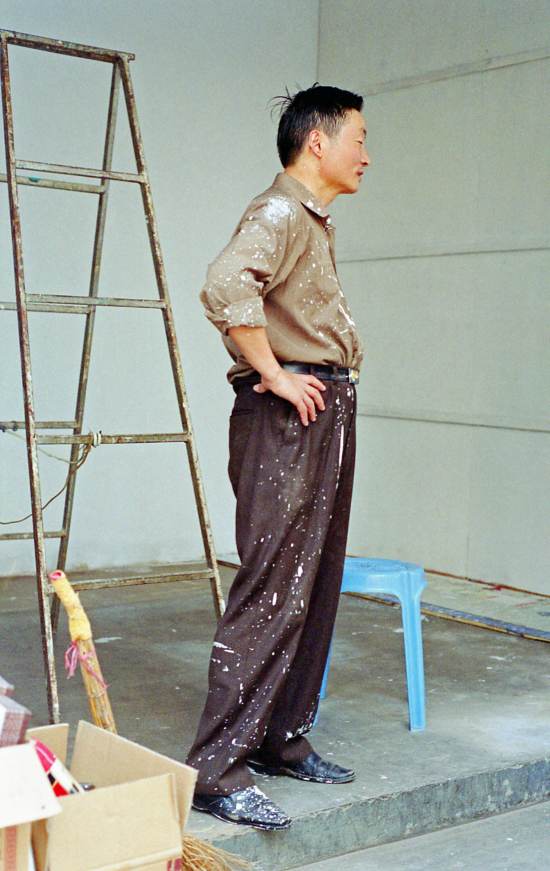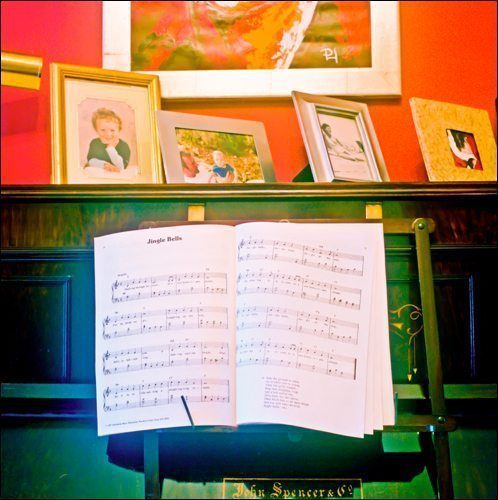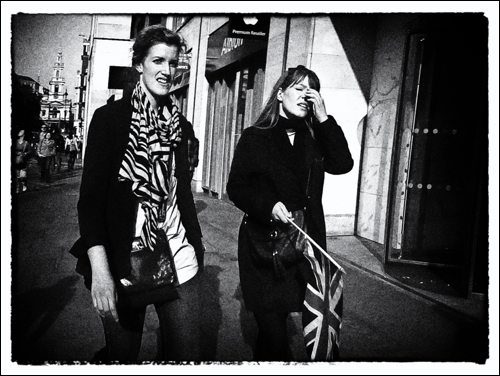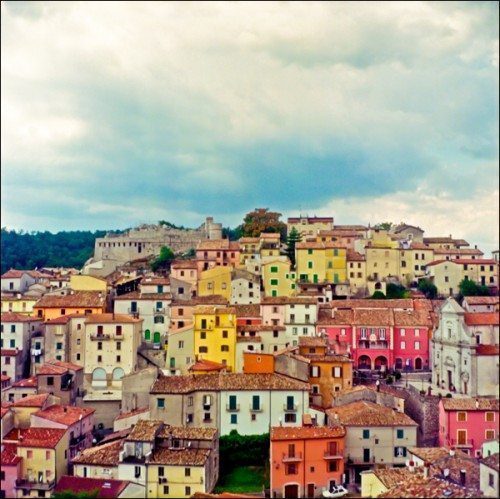Photographer Emma Sywyj has a wry approach to her craft.
Garishly-hued domestic objects outshine the natural colours of surrounding foliage in her Malaysia series; a foreboding of doom permeates her reportage of the most recent royal wedding, and her Interiors sequence casts an arch knowingness on the stock-photography and Habitat catalogue iconography of mid-90s consumerist aspirations. Trebuchet Magazine asked her some questions:
Trebuchet Magazine: How did you get started in photography?
Emma Sywyj:I was about 15 when I first asked to borrow an old Minolta 35mm camera that my mum had. My dad had got her into photography when they were dating in the 80’s. Then a couple of months after I got the camera I asked a woman who ran a small rock venue I frequented nicked named ‘The Wellie’ (short for the Wellington Boot, which was the name of the pub) if I could start taking photographs for the venue. I did mainly black and white photography and didn’t use a flash. A lot of my first attempts were quite blurry! But I got a few good shots in the end.
Trebuchet Magazine:What made you want to take photographs in the beginning?
Emma Sywyj: My father. He has always played me music and showed me art and was really into photography when he was younger. There is one story from when I was really young, maybe 4 or 5, and he gave me an adult sized automatic film camera. He put the strap round my wrist, whilst I had a balloon on the other hand. I accidently lost hold of the balloon and ran after it, dragging the camera along the gravel path as I went! He was a little upset about the camera! Me about the balloon!
So I guess I’ve been involved since I was a child really. But it was only when I became a teenager I really started to practice the art form. I was lucky enough to receive the cameras he’s passed down to me.
Trebuchet Magazine: Have you found other reasons to take photographs since then?
Emma Sywyj: Yes, ten years on I am more confident and capable artist and photographer. I use photography as a tool to understand the world around me in a broader more political sense. Especially when I am in new and exciting environments. As photography has become more popular and more accessible I feel a need to create fresh, diverse and exciting images.
it’s not about the importance of noticing, but more the about the importance of filtering
Trebuchet Magazine: How important is it (or not) to be conscious of what other photographers are doing?
Emma Sywyj: For me it’s unavoidable to not be conscious of other photographers. I see photography EVERYWHERE: used for advertising on the side of buses, billboards, on the front of magazine covers I read, on people’s Facebook accounts, on blogs etc. For me it’s not about the importance of noticing, but more the about the importance of filtering all this visual information.
Some people work in a commercial capacity, some people make fine art books, prints etc. For me I like to see tangents running across all these different parts of the photography world, that’s what is exciting. But some people can live completely secluded in a wood away from the world and create popular interesting works. I like to be up to date with what is happening around me. But if you have a passion in life I believe it’s good for you to explore all aspects of it anyway.
Trebuchet Magazine: Who influenced you in the beginning?
Emma Sywyj: Nan Goldin, Henri Cartier Bresson and a lot of people from Magnum. It’s a little cliché, but they are really amazing photographers.
Trebuchet Magazine: Who influences you now?
Emma Sywyj: I’m influenced by a lot of people working with video art, installations, graphic design and illustration. You can see this on my new website. My tastes in art have broadened outside of photography.
Trebuchet Magazine: How would you describe good photography?
Emma Sywyj: I think there are a few things that make an image stand out. One is an eternal truth, a photograph that represents something that will last through time. For instance Nan Goldin’s intimate portraits of her friends with their partners. Love and intimacy are things that everybody experiences from every generation in their lifetime, I would hope.
Philip Lorca Di Corcia’s photographs of people in street are also elegant & beautiful. They talk of the complex nature of human existence and the subject of the daily grind. Good photography is really when you see an image and it affects your gut not just your head.
I think you really need to be technically proficient before you can start to make imagery that might become iconic
Basic things like an understanding of composition, colour and light are also key to taking good photographs. I think you really need to be technically proficient before you can start to make imagery that might become iconic or start a new movement in some way. First things first!

Trebuchet Magazine: What do you look for in a photographic subject?
Emma Sywyj: Stillness, something that I can meditate on. Also something that in everyday life you might ignore but the photographic process can capture and illuminate banality into expression. Like Warhol with his Brillo boxes and Campbell soup prints. Mostly the subjects will vary, but it usually has something to do with a subject or question that has come up in my life at that time.
Trebuchet Magazine: Do you consider how people will react to your work?
Emma Sywyj: Not so much when I was younger as I didn’t really think about showing work till I got to the age of 18. I was encouraged to think about an audience at university. As I mentioned earlier we are exposed to so many images everyday, and people have become very blasé about photographic images that I like to challenge that mentality and create something exciting that will capture a short attention span.
Trebuchet Magazine: To what extent is emotion a component of your work?
Emma Sywyj: That’s what is so great about film cameras. I think how you feel about someone you shoot or a place really comes through on film, in a way it doesn’t quite do with digital camera technology. So with my film work my emotion and the emotion of a human subject is there like a thin layer permeating the image. It’s very subtle and implied. Most of my images capture some element of emotion but the emotions are quite restrained. Mostly the atmosphere of my work is very calm and people usually appear quite posed and still.

Trebuchet Magazine: What role does instinct play in the choices you make as a photographer?
Emma Sywyj: A lot, I am a very instinctive person. I live my life and make choices using my gut and my instinct most of the time. A lot of the time when I am travelling or doing a commercial shoot, I will shoot lots of imagery and might only edit once the shooting process is over. One of the better shots from a series or a shoot will be one where you aren’t thinking too much. I am big believer in ‘happy accidents’ sometimes these images can lead you in a new direction as well.
Trebuchet Magazine: When shooting a particular location do you try and capture the place from your understanding of it or from it’s own meaning?
Emma Sywyj: I think we all see the world very differently. That’s something that photography really highlights. We can see things in a similar way, but it is our upbringing and experiences subsequently as adults that shape our understanding of situations and the world.
When I was in China for the second time it was still all so wonderfully overwhelming. I think I was very aware of Orientalism. In fact a lot of the contemporary art I saw out there was about this particular subject/problem. But my understanding of the location changed every other day really, I think China is a very special place and had it’s own way of revealing it’s self to me. That was the joy of getting the imagery back, you think you have control over your work but nature does find a way sometimes.
Trebuchet Magazine: Your ‘Interiors’ series plays around with some of the aesthetics of mid-90s aspirational stock photography, but with much more wit. What did you have in mind when you did it?

Emma Sywyj: Thank you! Well the work was born out of a photography project I started at university. At the time I was moving every year to a new accommodation, from halls to shared houses. This is the way when you’re at university. There was a yearning I think to look into belonging and personal spaces. It was interesting to see how people lived in their homes. I always shot as soon as I met the people living inside, so they never really had time to tidy up etc. I took most of the imagery in South London, which is where I studied.
a yearning I think to look into belonging and personal spaces
What I’ve noticed about the imagery is there a real sense of absence, and isolation. Which was a surprise once I got the photos developed. There are no people in the photographs just traces of them. Which was really important.
Trebuchet Magazine: The Royal Wedding series shows a very different Britain from the newsreel Coronation footage it references. There’s a jaded knowingness to the people pictured that seems a common thread to modern experience. That media self-awareness is utterly lacking in 1950s reportage. Did you set out to catch that, or is it simply an unavoidable aspect of life now?
Emma Sywyj: I think I felt a bit jaded about the whole Royal Wedding really myself. I didn’t actually mean to watch it. But I was in London at the time and in down the road from Trafalgar Square and found myself getting sucked into the whole affair. I’m glad I did take part in my own way, as it was very exciting. The atmosphere was electric.

The way people come together around mass media events like this and next the Olympics is very interesting. Mass psychology is something that interests me a lot. I think the fact I chose to shoot in black and white and work on the series in a vintage fashion, was meant to ironic and a nod to the type of reportage photography I fell in love with when I was teenager.

But the way we process information and the amount of photographs that people have posted on the Internet about the wedding is into its tens of millions, which is so different from how things were in the 1950s. Also I think the fact the event was being broadcast live all over the world made people feel very conscious of themselves. CCTV culture adds to our sense of being watched and subsequent self-awareness too. I think also people wanted to be there to be seen to be there as well, like social kudos.
CCTV culture adds to our sense of being watched and subsequent self-awareness too
Trebuchet Magazine: There’s a townscape in your Italy series that has a really eye-catching block of green in the foreground. Once the eye latches onto it, other little pieces of the same green start to leap out of the shot. Was that a natural composition or did you help it a little?
Emma Sywyj: When I took the photograph I was originally struck by the geometry of the houses. I had no idea how vibrant they would come out in the actual photograph, which was nice surprise. My mother mentioned when seeing the image that the houses has been repainted and didn’t look like this when she went last in the late 90s.

The green is the natural foliage of the countryside. This town was built essentially at the top of a valley. The views from there are very beautiful and scenic. There isn’t much to do there other than walk around, play cards and soak up the sun. I think I felt compelled to photograph the town in a way that highlighted the difference between made things like buildings, to natural things like trees, mountains and flowers, etc. People there are very resourceful and make their own wine and cheese. I’m a bit of a city girl at heart, but fell in love with the atmosphere and relaxing nature of the town.
Trebuchet Magazine: Similarly, in the Malaysia series, there are flashes of almost unnatural colour. Is it easier to find vibrant shots in some locations? Harder in others?
Emma Sywyj: The unnatural colours came out my interest in the kitsch nature I found there. Again the town I was in was abundant in nature with jungles, mountains and tropical islands. Yet the town was permeated with several large shopping centres. All I did really whilst I was there was originally was eat and shop and spend time with my lovely family of course! It was again very relaxing.
Malaysia used to be economically challenged and now I see how western and built up it is. It’s becoming less primitive. So unless I go somewhere really deserted and natural, there is usually neon, colour and manmade tones all around.
Trebuchet Magazine: What about that pre-conceived sense of expectation that comes with reportage – that Germany will be all industrial greys and browns, China will feature lots of red, Italy will be terracotta and burnt umber. Is it fun playing with those preconceptions?
Emma Sywyj: I don’t really like typical, unless it is done ironically or with a twist! I have a sense of humour so it’s nice to hear that comes across in my photography.
Clichés and stereotypes are things I like to stay away from in general, and find the finer points of culture to notice. Globalisation has had such an impact on the way we experience life now as well. Often we can travel for thousands of miles and see a fast food place you would see somewhere back home. Which can be a little disheartening.
It’s definitely important to challenge yourself to create a new perspective on a place, person or situation and if you can challenge your viewer as well, that’s always good.
All photos Emma Sywyj http://www.emma-sywyj.com/

An observer first and foremost, Sean Keenan takes what he sees and forges words from the pictures. Media, critique, exuberant analysis and occasional remorse.

















